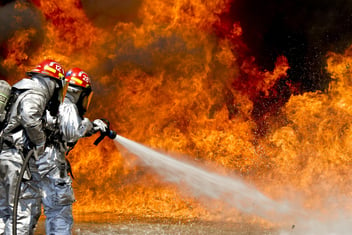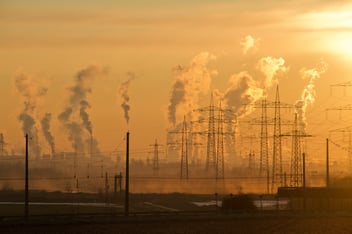Keywords: heatwave preparedness plan, heatwave action plan, heatwave risk management, climate resilience strategy, heatwave business continuity, heatwave response protocols, sector-specific heatwave guides, proactive risk management heat, extreme heat workplace safety
TLDR - we made heatwave guides, get yours here.
Heatwaves Are No Longer Outliers & They Are Systemic Risk Events
Why Heatwaves Are Now a Serious Threat to Operations Everywhere
Extreme heat is now one of the most serious climate-linked risks facing global economies. From health and safety to supply chain fragility, grid failure, and lost productivity, heatwaves are disrupting critical systems in ways that are costly, compounding, and increasingly unavoidable.
The 2022 European heatwave alone caused over 70,000 deaths, the deadliest weather-related disaster in decades. In the U.S., heatwaves now kill more people annually than hurricanes, floods, or wildfires, and cost billions in lost labour, insurance payouts, and power outages.
But it’s not just lives at risk — it’s livelihoods. Heatwaves now influence:
-
Power prices and grid stability
-
Agricultural yield and food inflation
-
Insurance claims and risk models
-
Labour availability and productivity
-
Construction schedules and materials performance
-
Financial market volatility and ESG compliance
And the data is clear: heatwaves are growing in frequency, duration, and intensity, and industries are not prepared.
What Is a Heatwave Preparedness Plan?
A heatwave preparedness plan is a structured, operational tool designed to help businesses respond to rising temperatures before crisis hits. It typically includes:
-
Heat threshold levels and trigger points
-
Team roles and responsibilities during heat events
-
Communication workflows and emergency escalation protocols
-
Protective measures for people, equipment, and operations
-
Templates and checklists for consistent execution
Unlike traditional business continuity plans, a heatwave action plan is tied to real-world temperature forecasts and industry-specific impacts. It’s the bridge between climate data and operational action.
Why is this important? Because proactive response is always cheaper, faster, and safer than reactive firefighting.

Why Proactive Heatwave Planning Is Cost-Effective
Studies from the ILO, FAO, and OECD consistently show that the financial costs of inaction during heatwaves far exceed the cost of preparation. Proactive heatwave planning helps organisations:
-
Avoid costly shutdowns and delays
-
Minimise insurance premiums or payouts
-
Reduce staff injury, absenteeism, and turnover
-
Improve ESG scores and investor confidence
-
Build credibility with partners and regulators
-
Protect critical assets and infrastructure
A heatwave preparedness plan is not just a safety document; it’s a risk management strategy, a climate adaptation tool, and a business enabler.
Risk Perception: The Hidden Issue
Research shows that perception drives action. Organisations that understand their climate risk — and internalise heat as a real threat; act sooner, communicate better, and recover faster.
“The difference between impact and non-impact is often not the hazard itself, but whether people believe it’s real enough to act on.”
Preparedness plans shape that belief. They help turn abstract climate threats into tangible, operational protocols; enabling faster, coordinated response when thresholds are crossed.
What Industries Need a Heatwave Action Plan?
All of them.
But here are the key industries already feeling the heat:
-
Construction – Delays, heatstroke, equipment failure
-
Energy – Cooling demand surges, substation overheating, outages
-
Agriculture – Crop failure, livestock mortality, field labour disruption
-
Finance – Commodities volatility, insurance losses, ESG exposure
-
Logistics – Infrastructure buckling, fuel spoilage, heat fatigue
-
Healthcare – ER surges, power loss, medication instability
-
Retail – Supply chain fragility, stock spoilage, AC dependency
-
Real Estate & Facilities – Tenant risk, HVAC overload, asset devaluation
-
Insurance & Reinsurance – Climate-linked claims, unmodelled risk, parametric triggers
Construction: Heatwaves and Project Risk
Keywords: heatwave construction delays, construction heat risk, worker safety extreme heat, temperature thresholds construction
Construction is one of the most physically exposed industries. When temperatures rise:
-
Worker productivity drops up to 30–40%
-
Concrete performance degrades
-
PPE compliance becomes unsafe
-
Schedules slip, triggering contractual penalties
-
Legal liability rises if heat illnesses go unmanaged
A construction heatwave plan defines safe working thresholds (e.g. 28°C = monitor, 35°C = shift changes), hydration protocols, and weather-linked scheduling tools, helping contractors stay safe and on time.

Energy: Grid Stability Under Pressure
Keywords: heatwave power outages, energy sector heat risk, electricity demand spikes, cooling demand surge, infrastructure resilience energy
Heatwaves hit the energy sector from both sides: demand surges from AC and cooling needs, while supply is constrained by:
-
Turbine and substation overheating
-
Transmission line losses (thermal sag)
-
Reduced efficiency in solar and hydro
Without thresholds and response triggers, blackouts, equipment failure, and regulatory breaches become likely.
A strong heatwave plan in energy includes load forecasting, equipment derating thresholds, cooling alerts, and grid contingency routing, turning temperature spikes into manageable load events.
Agriculture: Protecting Yield, Labour, and Livestock
Keywords: heatwave agriculture risk, livestock heat stress, irrigation during extreme heat, crop failure extreme heat, farmworker safety plan
Agriculture is being redefined by heat extremes. Above 32°C, crops like maize and wheat begin to suffer irreversible stress. Poultry and pigs experience high mortality. Dairy yield drops. And farmworkers face unsafe conditions.
A sector-specific agricultural heatwave plan includes:
-
Livestock cooling and hydration protocols
-
Shade and shelter management
-
Irrigation timing and evapotranspiration thresholds
-
Labour rescheduling and emergency shade breaks
-
Yield loss tracking and insurance triggers
This isn’t future risk, it’s here now! In 2023, India and China saw massive crop failures and livestock deaths during prolonged heat events.
Finance: Trading Signals and Sector Exposure
Keywords: heatwave trading strategy, climate risk finance, ESG heat stress, commodity market heat impact, insurance claims heatwaves
Finance professionals are often downstream from physical impact — but they hold the capital behind the risk.
Extreme heat moves markets:
-
Commodities: Corn, wheat, natural gas spike
-
Equities: Utilities, HVAC, QSRs, agtech rise; insurers and re/insurers fall
-
Insurance: Claims rise in casualty, crop, and business interruption
-
Fixed Income: Sovereigns with unhedged ag or energy sectors face risk
-
ESG/Disclosures: Failure to disclose heat exposure is now a red flag
Traders and analysts need heatwave signal frameworks, financial impact thresholds, and climate-aligned asset screening to stay ahead.
Why We Built Sector-Specific Heatwave Guides
To close the gap between forecast and action, we created a growing suite of free, detailed Heatwave Preparedness Guides for:
-
Construction
-
Energy
-
Agriculture
-
Finance & Trading
Each guide includes:
-
Heat threshold definitions
-
Sample response plans and roles
-
Communication templates
-
Monitoring and reporting tools
-
Links to global standards (FAO, WMO, OSHA, etc.)
More guides are coming soon; including for logistics, real estate, municipalities, and data centres.
Take Action: Download Your Heatwave Guide Today
Whether you run a job site, an energy portfolio, a farm, or a trading desk, heatwaves are no longer a distant climate story. They’re a direct operational threat that your organisation must be ready for.
With the right plan in place, you can protect people, preserve value, and respond faster when the next heatwave hits.



